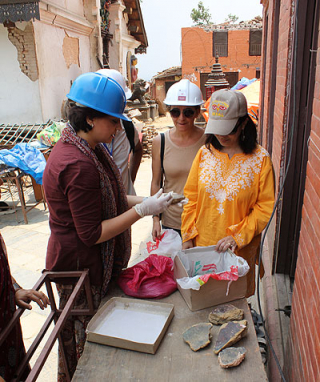When news of the massive earthquake in Nepal broke out, ICCROM led an initiative to produce the Kathmandu Cultural Emergency Crowdmap, which received extensive on-the-ground reports about damaged heritage. As a result, an overview of the devastation was pulled together immediately and now an international team is in Kathmandu preparing the groundwork for a sustainable salvage operation.
“Through on-site assessments we have been able to see for ourselves how people in Nepal have come forward to salvage and secure their cultural sites, religious shrines and city squares,” says Aparna Tandon, in charge of the cultural disaster risk programme at ICCROM, the International Centre for the Study of the Preservation and Restoration of Cultural Property.
Together with specialists from ICOMOS (International Council of Monuments and Sites), ICOM (International Council of Museums), the Smithsonian Institution , the UNESCO Office in Kathmandu, and with the generous support of Prince Claus Fund (The Netherlands). they are working closely with the Nepalese Department of Archaeology to devise a strategic plan for aid and recovery to be carried out in coordination with humanitarian efforts.
As the scale of damage is enormous and resources limited, there is a need to design and test appropriate workflows for stabilization and recovery operations, the kind that could be then adopted and applied to other affected collections and sites in the coming months. In order to do this, the team will initiate intensive training, which will target local heritage workers and volunteers on two selected heritage assets: the Hanuman Dhoka museum collection and Sankarapur Temple in Sankhu.
ICCROM has considerable experience in emergency training for cultural heritage practitioners in the event of a crisis or disaster. Following the earthquake in Haiti in 2010, Tandon developed an innovative methodology that ICCROM calls “First Aid to Cultural Heritage”. Since then, regular courses on this subject have been held all over the world, and trainees of the First Aid courses are now teaching the process to others. The idea is to build local capacities and strengthen their resilience in the event of a future catastrophe.
“Since its creation after the Second World War, ICCROM’s mission has always been associated with disaster recovery. Sixty years of experience has taught us that on one hand cultural ‘first aid’ restores dignity, identity and faith in the value of heritage, so desperately needed in the face of enormous loss. On the other hand, it is also becoming increasingly crucial to know how to be prepared, so we also need to create organizational structures that are able to react quickly and effectively,” says Stefano De Caro, ICCROM’s Director-General.
“We are now in crisis and mourning, faced with unimaginable devastation and insurmountable loss. Temples, stupas, and wayside shrines are tangible symbols of our cultural heritage, of our faith that unites us as a nation,” says Dr. Dina Bangdel, a cultural historian of Nepalese art currently working with the Department of Archaeology to salvage the Swayambhu World Heritage site and its associated Shrine of Shantipur. “At this critical juncture, ICCROM’s efforts in cultural recovery of the early phase and long-term are urgently required, and will be invaluable for Nepal for the rebuilding of a nation, and rebuilding of hope, ” Bangdel adds.
With the upcoming monsoon season, these activities have become all the more critical with cultural heritage risking further damage.

